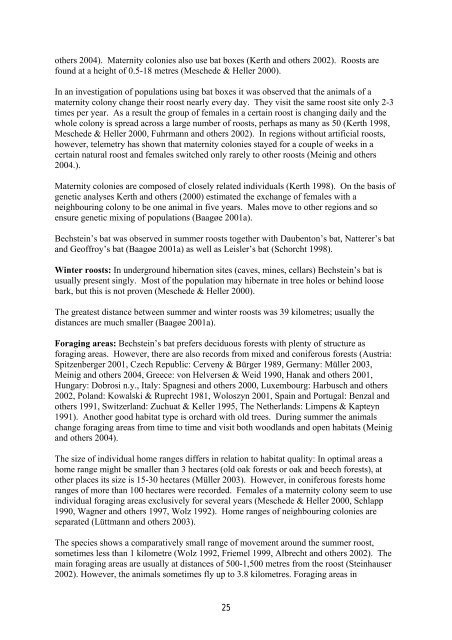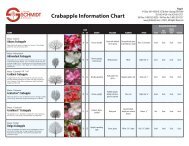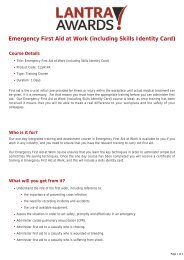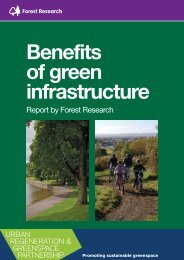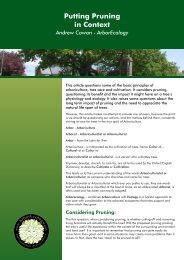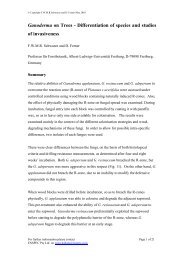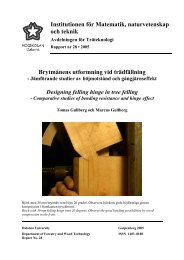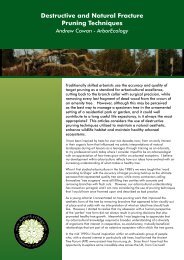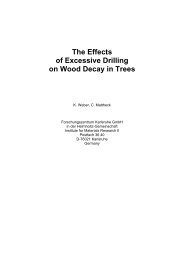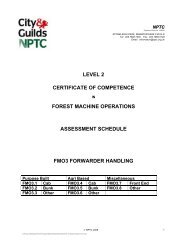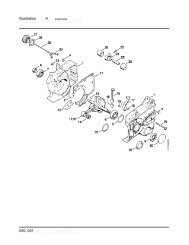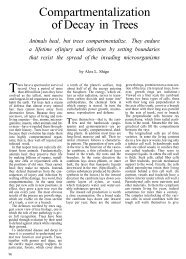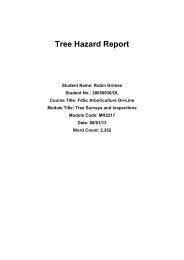Other roosts: There seem to be special migration roosts where animals meet in early spring(March-April) and in autumn (October-November) (Ohlendorf 2002a).Foraging areas: Foraging areas of Natterer’s bat are in deciduous, mixed and coniferous<strong>for</strong>ests, along <strong>for</strong>est edges, tree rows, hedges, and in pasture and arable land (Austria:Spitzenberger 2001, Georgia: Abuladze and others 2001, Germany: Trappmann 1996,Siemers & Schnitzler 1999, Kretzschmar 2003, Hungary: Dobrosi n.y., Greece: Hanak andothers 2001, Italy: Spagnesi and others 2000, Poland: Kowalski & Ruprecht 1981, Woloszyn2001, Spain and Portugal: Benzal and others 1991, The Netherlands: Limpens & Kapteyn1991, Limpens & Bongers 1991, Sweden: de Jong 1995, Switzerland: Ruedi and others1995). In springtime most <strong>for</strong>aging activity is in open habitats such as orchards, fields andpastures with hedgerows and trees or near waters. However, in summer, <strong>for</strong>aging activity isconcentrated in woodlands and the species even uses dense coniferous <strong>for</strong>ests. Meier (2002)and Kockerbeck (2002) observed that females with roosts in <strong>for</strong>ests also preferred to <strong>for</strong>agein the <strong>for</strong>est. Areas outside the <strong>for</strong>est were visited only on rare occasions. Other females,which raised their young in cattle sheds, <strong>for</strong>aged in open habitats to a greater extent and alsohunted in the stables.Natterer’s bat prefers <strong>for</strong>aging areas at distances of 1,500 metres from the roost site, eachwith a size of two to 20 hectares (Trappmann & Clemen 2001, Meier 2002, Kockerbeck2002, Kretzschmar 2003). Such core areas within a home range of 100-600 hectares, whichare visited every night by the same individuals, were also identified by Siemers and others(1999) in south-western Germany. A speciality are <strong>for</strong>aging sites in cattle stables where thebats roost and feed on flies, so they do not have to leave the stable during summer(Trappmann & Clemen 2001, Simon and others 2004).Foraging areas may be up to 3 kilometres from the roost site, but in late summer and autumnthey are rarely more than 600 metres away from the roost (Meschede & Heller 2000,Kretzschmar 2003). In western Germany, males were observed to <strong>for</strong>age at distances of 350-1,000 metres from the roost, and females at 1-1,5 kilometres. As an exception maximumdistances of 3.3 kilometres and even 4.8 kilometres were recorded (Trappmann & Clemen2001, Meier 2002, Kockerbeck 2002).On its way to the <strong>for</strong>aging areas Natterer’s bat often uses flight paths along linear featureslike hedges and alleys (Meschede & Heller 2000). During the night the animals frequentlychange their <strong>for</strong>aging areas, which they share with other bats of the same species (Trappmann& Clemen 2001, Meier 2002, Kockerbeck 2002).Abundance: In the district of Marburg-Biedenkopf in central Germany, Simon and others(2004) estimated the abundance to be 0.16 female Natterer’s bats per square kilometre,however, they presumed 1 female per square kilometre was more realistic.3.7 Bechstein’s bat Myotis bechsteiniiHabitat <strong>for</strong>est types: Deciduous <strong>for</strong>ests are the dominant habitats <strong>for</strong> roosting, <strong>for</strong>aging andprobably hibernation also. As the species is only occasionally observed in other <strong>for</strong>est typesor outside <strong>for</strong>ests, Bechstein’s bat is the most characteristic mid-European woodland bat.Summer roosts: Most summer roosts are in woodpecker holes, sometimes behind loose barkor in tree crevices (Fuhrmann & Godmann 1994, Meschede & Heller 2000, Meinig and24
others 2004). Maternity colonies also use bat boxes (Kerth and others 2002). Roosts arefound at a height of 0.5-18 metres (Meschede & Heller 2000).In an investigation of populations using bat boxes it was observed that the animals of amaternity colony change their roost nearly every day. They visit the same roost site only 2-3times per year. As a result the group of females in a certain roost is changing daily and thewhole colony is spread across a large number of roosts, perhaps as many as 50 (Kerth 1998,Meschede & Heller 2000, Fuhrmann and others 2002). In regions without artificial roosts,however, telemetry has shown that maternity colonies stayed <strong>for</strong> a couple of weeks in acertain natural roost and females switched only rarely to other roosts (Meinig and others2004.).Maternity colonies are composed of closely related individuals (Kerth 1998). On the basis ofgenetic analyses Kerth and others (2000) estimated the exchange of females with aneighbouring colony to be one animal in five years. Males move to other regions and soensure genetic mixing of populations (Baagøe 2001a).Bechstein’s bat was observed in summer roosts together with Daubenton’s bat, Natterer’s batand Geoffroy’s bat (Baagøe 2001a) as well as Leisler’s bat (Schorcht 1998).Winter roosts: In underground hibernation sites (caves, mines, cellars) Bechstein’s bat isusually present singly. Most of the population may hibernate in tree holes or behind loosebark, but this is not proven (Meschede & Heller 2000).The greatest distance between summer and winter roosts was 39 kilometres; usually thedistances are much smaller (Baagøe 2001a).Foraging areas: Bechstein’s bat prefers deciduous <strong>for</strong>ests with plenty of structure as<strong>for</strong>aging areas. However, there are also records from mixed and coniferous <strong>for</strong>ests (Austria:Spitzenberger 2001, Czech Republic: Cerveny & Bürger 1989, Germany: Müller 2003,Meinig and others 2004, Greece: von Helversen & Weid 1990, Hanak and others 2001,Hungary: Dobrosi n.y., Italy: Spagnesi and others 2000, Luxembourg: Harbusch and others2002, Poland: Kowalski & Ruprecht 1981, Woloszyn 2001, Spain and Portugal: Benzal andothers 1991, Switzerland: Zuchuat & Keller 1995, The Netherlands: Limpens & Kapteyn1991). Another good habitat type is orchard with old trees. During summer the animalschange <strong>for</strong>aging areas from time to time and visit both woodlands and open habitats (Meinigand others 2004).The size of individual home ranges differs in relation to habitat quality: In optimal areas ahome range might be smaller than 3 hectares (old oak <strong>for</strong>ests or oak and beech <strong>for</strong>ests), atother places its size is 15-30 hectares (Müller 2003). However, in coniferous <strong>for</strong>ests homeranges of more than 100 hectares were recorded. Females of a maternity colony seem to useindividual <strong>for</strong>aging areas exclusively <strong>for</strong> several years (Meschede & Heller 2000, Schlapp1990, Wagner and others 1997, Wolz 1992). Home ranges of neighbouring colonies areseparated (Lüttmann and others 2003).The species shows a comparatively small range of movement around the summer roost,sometimes less than 1 kilometre (Wolz 1992, Friemel 1999, Albrecht and others 2002). Themain <strong>for</strong>aging areas are usually at distances of 500-1,500 metres from the roost (Steinhauser2002). However, the animals sometimes fly up to 3.8 kilometres. Foraging areas in25
- Page 3: English Nature Research ReportsNumb
- Page 7 and 8: ContentsPreamble1. Legal aspects...
- Page 9 and 10: 1. Legal aspectsThere are three int
- Page 11 and 12: to the Agreement decided that the c
- Page 13 and 14: Country European Community EUROBATS
- Page 15 and 16: types in Europe where many of the e
- Page 17 and 18: • the European Commission initiat
- Page 19 and 20: Foraging areas: Central European sp
- Page 21 and 22: Other roosts: In foraging areas and
- Page 23: Brandt’s bat travels up to 250 ki
- Page 27 and 28: 1995, The Netherlands: Limpens and
- Page 29 and 30: from a maternity colony covered a t
- Page 31 and 32: hibernaculum is the Levensau Bridge
- Page 33 and 34: female (Fuhrmann and others 2002).
- Page 35 and 36: Foraging areas: In Central Europe f
- Page 37 and 38: Table 2 Importance of tree holes fo
- Page 39 and 40: sites it was found that the possibi
- Page 41 and 42: advancing age of a tree its potenti
- Page 43 and 44: floor up to the canopy and beyond c
- Page 45 and 46: Table 6 Overview of the most freque
- Page 47 and 48: 6.2 2nd step: Active search for roo
- Page 49 and 50: This first approach to a woodland b
- Page 51 and 52: number of tree-dwelling birds in pr
- Page 53 and 54: Types of boxes used by batsThere ar
- Page 55 and 56: oxes exposed to the sun. As an exam
- Page 57 and 58: Con: Bats use bat boxes selectively
- Page 59 and 60: 9. ReferencesABULADZE, A., BUXNIKAS
- Page 61 and 62: BEKKER, J.P. 1990. Ervaringen met v
- Page 63 and 64: BRAUN, M., & HÄUSSLER, U. 2003c. K
- Page 65 and 66: Ökologie und Verbreitung von Arten
- Page 67 and 68: (Germany). In: PRIEDE, I. G. & SWIF
- Page 69 and 70: (Nyctalus leisleri) sowie zur Besie
- Page 71 and 72: HEISE, G. 1985. Zu Vorkommen, Phän
- Page 73 and 74: JONES, G. 1990. Prey selection by t
- Page 75 and 76:
(Chiroptera: Vespertilionidae). - P
- Page 77 and 78:
Ökologie und Verbreitung von Arten
- Page 79 and 80:
PÉREZ, J. L. & IBÁÑEZ, C. 1991.
- Page 81 and 82:
ROTTMANN, R., BOYE, P. & MEINIG, H.
- Page 83 and 84:
SCHORCHT, W., and others. 2002. Zur
- Page 85 and 86:
STUTZ, H.-P. B. & HAFFNER, M. 1989.
- Page 87 and 88:
WAGNER, M., KERTH, G. & KÖNIG, B.
- Page 89:
10. AuthorsDr. Peter Boye became fa


